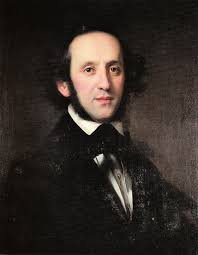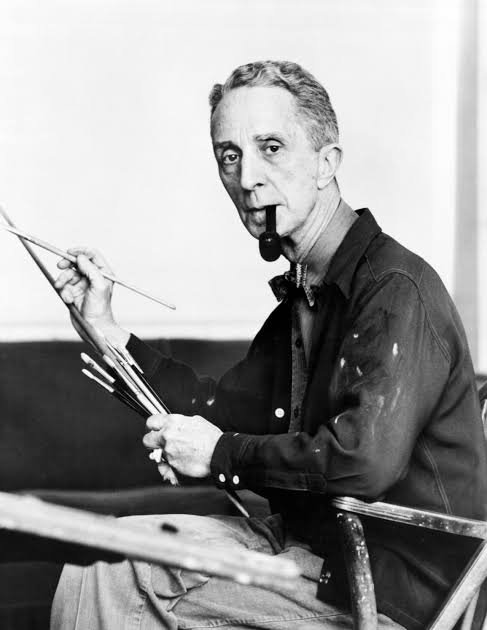FEBRUARY 3
FELIX MENDELSSOHN (Feb. 3, 1809)
February 3 is the birthday of German composer FELIX MENDELSSOHN (1809-1847).
"Though everything else may appear shallow and repulsive, even the smallest task in music is so absorbing, and carries us so far away from town, country, earth, and all worldly things, that it is truly a blessed gift of God."
Mendelssohn "was a German composer, pianist, organist and conductor of the early Romantic period. Mendelssohn's compositions include symphonies, concertos, piano music, organ music and chamber music. His best-known works include the overture and incidental music for A Midsummer Night's Dream (which includes his 'Wedding March'), the Italian and Scottish Symphonies, the oratorios St. Paul and Elijah, the Hebrides Overture, the mature Violin Concerto, the String Octet, and the melody used in the Christmas carol 'Hark! The Herald Angels Sing!' Mendelssohn's Songs Without Words are his most famous solo piano compositions." (Wikipedia)
GERTRUDE STEIN (Feb. 3, 1874)
February 3 is the birthday of American author GERTRUDE STEIN (1874-1946).
"To write is to write is to write is to write is to write is to write is to write is to write."
One of Stein's most famous works is her libretto for Virgil Thomson's opera FOUR SAINTS IN THREE ACTS, which features an all-black cast.
"The opera features two 16th-century Spanish saints—the former mercenary Ignatius of Loyola and the mystic Teresa of Avila—as well as their colleagues, real and imagined: St. Plan, St. Settlement, St. Plot, St. Chavez, etc. Thomson decided to divide St. Teresa's role between two singers, "St. Teresa I" and "St. Teresa II", and added the master and mistress of ceremonies (Compère and Commère—literally, the "godparents") to sing Stein's stage directions...
The sets of the first production, designed by artist Florine Stettheimer, included innovative cellophane backdrops and brilliant pure white lighting, and the costumes (also Stettheimer's) were of colorful lace, silk and taffeta. Frederick Ashton provided the choreography (after George Balanchine turned down the job).
Also considered unusual was the portrayal of the European saints by an all-black cast, for which there was no precedent in American history. These unconventional elements led to a successful and well-received first production. While critics were divided, audiences accepted the fantasy world created by the singers, who vividly conveyed the words and melodies given to their saintly characters." (Wikipedia)
CARL THEODOR DREYER (Feb. 3, 1889)
February 3 is the birthday of Danish film director CARL THEODOR DREYER (1889-1968).
"Nothing in the world can be compared to the human face."
Dreyer is regarded by many critics and filmmakers as one of the greatest directors in cinema. His best known films include Vampyr (1932), Day of Wrath (1943), Ordet (1955), Gertrud (1964) and THE PASSION OF JOAN OF ARC (1928).
NORMAN ROCKWELL (Feb. 3, 1894)
February 3 is the birthday of American painter and illustrator NORMAN ROCKWELL (1894-1978).
"Some people have been kind enough to call me a fine artist. I've always called myself an illustrator. I'm not sure what the difference is. All I know is that whatever type of work I do, I try to give it my very best. Art has been my life."
Rockwell's "works have a broad popular appeal in the United States for their reflection of the country's culture. Rockwell is most famous for the cover illustrations of everyday life he created for The Saturday Evening Post magazine over nearly five decades. Among the best-known of Rockwell's works are the Willie Gillis series, Rosie the Riveter, the Four Freedoms series, Saying Grace, and The Problem We All Live With. He is also noted for his 64-year relationship with the Boy Scouts of America (BSA), during which he produced covers for their publication Boys' Life (now Scout Life), calendars, and other illustrations. These works include popular images that reflect the Scout Oath and Scout Law such as The Scoutmaster, A Scout Is Reverent, and A Guiding Hand." (Wikipedia)
THIS DAY IN HISTORY
CHOPSTICKS
On February 3, 1877, 16 year-old Euphemia Bell (under the pseudonymn Arthur de Lull) registered her composition "Chopsticks" at the British Museum. It wasn't named after the Chinese eating utensil, but after the way Euphemia advised people to play the piece, with a chopping motion.






